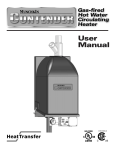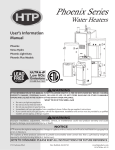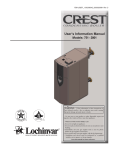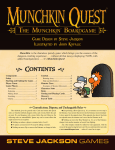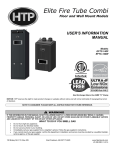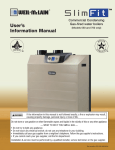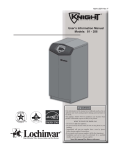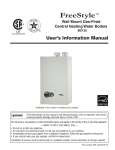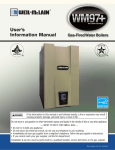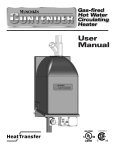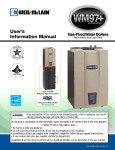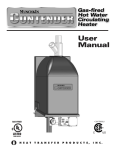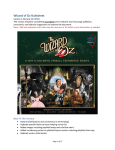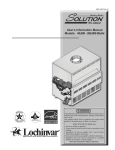Download User Manual (2)
Transcript
User Manual GAS-FIRED BOILER TABLE OF CONTENTS Product and Safety Information . . . . . . . . . . . . . . . . . . . . . . . . . . . . . . . . . . . . . . . . . . . . . 2,3 Service and Maintenance Munchkin Operation Primary Water Section I – Combustion Air – Prevention of Contamination. . . . . . . . . . . . . . . . . . . . . . . . 4 Potential Contaminating Products Areas likely to find these Products Section II – Maintenance Schedule . . . . . . . . . . . . . . . . . . . . . . . . . . . . . . . . . . . . . . . . . . 4,5 Service Technician Owner Maintenance Section III – Maintenance Procedures . . . . . . . . . . . . . . . . . . . . . . . . . . . . . . . . . . . . . . . . 5-7 Daily Maintenance Monthly Maintenance 6 Month Maintenance Section IV – Start-Up Procedure . . . . . . . . . . . . . . . . . . . . . . . . . . . . . . . . . . . . . . . . . . . . . . 8 Replacement Parts . . . . . . . . . . . . . . . . . . . . . . . . . . . . . . . . . . . . . . . . . . . . . . . . . . . . . . . . 9-12 WARNING If the information in this manual is not followed exactly, a fire or explosion may result causing property damage, personal injury or loss of life. Do not store or use gasoline or other flammable vapors and liquids in the vicinity of this or any other appliance. WHAT TO DO IF YOU SMELL GAS • Do not try to light any appliance. • Do not touch any electrical switch: do not use any phone in your building. • Immediately call your gas supplier from a neighbor's phone. Follow the gas supplier's instructions. • If you cannot reach your gas supplier, call the fire department. Installation and service must be performed by a qualified installer, service agency or the gas supplier. 1 User Manual GAS-FIRED BOILER PRODUCT AND SAFETY INFORMATION SPECIAL ATTENTION BOXES The following defined terms are used throughout this manual to bring attention to the presence of hazards of various risk levels or to important information concerning the product. DEFINITIONS DANGER DANGER indicates an imminently hazardous situation which, if not avoided, will result in death or serious injury. WARNING WARNING indicates a potentially hazardous situation which, if not avoided, could result in death or serious injury. CAUTION CAUTION Indicates a potentially hazardous situation which, if not avoided, may result in minor or moderate injury. CAUTION CAUTION used without the safety alert symbol indicates a potentially hazardous situation which, if not avoided, may result in property damage. NOTICE Heat Transfer Products, Inc., reserves the right to make product changes or updates without notice and will not be held liable for typographical errors in literature. 2 User Manual GAS-FIRED BOILER PRODUCT AND SAFETY INFORMATION (CONT’D) PRIMARY WATER WARNING User — Have this boiler serviced/inspected by a qualified service technician annually. • If you have an old system with cast iron radiators, thoroughly flush the system (without boiler connected) to remove sediment. The high-efficiency heat exchanger can be damaged by build-up or corrosion due to sediment. • Do not use petroleum-based cleaning or sealing compounds in boiler system. Gaskets and seals in the system may be damaged. This can result in substantial property damage. • Do not use “homemade cures” or “boiler patent medicines.” Substantial property damage, damage to boiler, and/or serious personal injury may result. • Continual fresh make-up water will reduce boiler life. Mineral buildup in heat exchanger reduces heat transfer, overheats the stainless steel heat exchanger, and causes failure. Addition of oxygen carried in by make-up water can cause internal corrosion in system components. Leaks in boiler or piping must be repaired at once to prevent make-up water. WARNING Failure to adhere to the guidelines on this page can result in severe personal injury, death or substantial property damage. WARNING WHAT TO DO IF YOU SMELL GAS • Do not try to light any appliance. • Do not touch any electric switch; do not use any phone in your building. • Immediately call your gas supplier from a neighbor's phone. Follow the gas suppliers' instructions. • If you cannot reach your gas supplier, call the fire department. BOILER OPERATION • Do not block flow of combustion or ventilation air to boiler. • Should overheating occur or gas supply fail to shut off, do not turn off or disconnect electrical supply to circulator. Instead, shut off the gas supply at a location external to the appliance. • 3 Do not use this boiler if any part has been under water. Immediately call a qualified service technician to inspect the boiler and to replace any part of the control system and any gas control that has been under water. FREEZE PROTECTION FLUIDS CAUTION NEVER use automotive or standard glycol antifreeze, even ethylene glycol made for hydronic systems. Use only inhibited propylene glycol solutions, which are specifically formulated for hydronic systems. Ethylene glycol is toxic and can attack gaskets and seals used in hydronic systems. User Manual GAS-FIRED BOILER SECTION I – COMBUSTION AIR – PREVENTION OF CONTAMINATION AREAS LIKELY TO FIND THESE PRODUCTS WARNING Products to avoid If the Munchkin combustion air inlet is located in any area likely to cause or contain contamination, or if products, which would contaminate the air cannot be removed, the combustion air must be re -piped and terminated to another location. Contaminated combustion air will damage the unit and its burner system, resulting in possible severe personal injury, death or substantial property damage. Spray cans containing fluorocarbons Permanent wave solutions Chlorinated waxes/cleaners Chlorine-based swimming pool chemicals Calcium chloride used for thawing Sodium chloride used for water softening Refrigerant leaks Paint or varnish removers Hydrochloric acid/muriatic acid Cements and glues Antistatic fabric softeners used in clothes dryers Chlorine-type bleaches, detergents, and cleaning solvents found in household laundry rooms Adhesives used to fasten building products and other similar products WARNING Do not operate a Munchkin unit if its combustion air inlet or the unit is located in or near a laundry room or pool facility. These areas will always contain hazardous contaminates. Pool and laundry products and common household and hobby products often contain fluorine or chlorine compounds. When these chemicals pass through the burner and vent system, they can form strong acids. These acids can create corrosion of the heat exchanger, burner components and vent system, causing serious damage and presenting a possible threat of flue gas spillage or water leakage into the surrounding area. Areas likely to have contaminants Dry cleaning/laundry areas and establishments Swimming pools Metal fabrication plants Beauty shops Refrigeration repair shops Photo processing plants Auto body shops Plastic manufacturing plants Furniture refinishing areas and establishments New building construction Remodeling areas Garages and workshops SECTION II – MAINTENANCE SCHEDULE SERVICE TECHNICIAN On an annual basis the following maintenance should be performed by a qualified service technician: • Check boiler water pressure, piping and expansion tank. • Check control settings. • Check ignition electrode (use Scotch Brite Pad and sand off any white oxide; clean and reposition). • Check ignition wiring and ground wiring. • Check all control wiring and connections. • Check burner flame pattern (stable and uniform) and flame. General • Attend to any reported problems. • Inspect the interior of the boiler jacket area; clean and vacuum if necessary. • Clean the condensate trap and fill with fresh water. • Check for leaks: water, gas, flue and condensate. • Verify flue vent piping and air inlet piping are in good condition and sealed tight. Additional items if combustion or performance is poor: • Clean heat exchanger and flue ways. • Remove burner assembly and clean burner 4 User Manual GAS-FIRED BOILER SECTION II – MAINTENANCE SCHEDULE (CONT’D) head using compressed air only. Once the maintenance items are completed, review the service with the owner. OWNER MAINTENANCE Periodically: • Check the area around the unit. • Check and remove any blockage from the combustion air inlet and ventilation openings. • Check the temperature/pressure gauge Monthly: • Check vent piping. • Check combustion air inlet piping. • Check the pressure relief valve. • Check the condensate drain system. Every 6 months: • Check boiler piping and gas supply piping for corrosion or potential signs of leakage. WARNING Follow the maintenance procedures given throughout this manual. Failure to perform the service and maintenance or follow the directions in this manual could result in damage to the Munchkin or in system components, resulting in severe personal injury, death or substantial property damage. SECTION III – MAINTENANCE PROCEDURES WARNING The Munchkin must be inspected and serviced annually, preferably at the start of the heating season, by a qualified service technician. In addition, the maintenance and care of the boiler as outlined on page 3 and further explained on pages 4 through 6 must be performed to assure maximum efficiency and reliability of the unit. Failure to service and maintain the Munchkin and the system components could result in equipment failure, causing possible severe personal injury, death or substantial property damage. NOTICE The following information provides detailed instruction for completing the maintenance items outlined in the maintenance schedule in Section II. In addition to this maintenance, the Munchkin should be serviced at the beginning of the heating season by a qualified service technician. DAILY MAINTENANCE Check the surrounding area 5 WARNING To prevent potential of severe personal injury, death or substantial property damage, eliminate all the materials listed in Section I from the area surrounding the unit and from the vicinity of the combustion air inlet. If contaminates are found: Remove products immediately from the area. If they have been there for an extended period, call a qualified service technician to inspect the unit for possible damage from acid corrosion. If products cannot be removed, immediately call a qualified service technician to re-pipe the combustion air inlet piping and locate the combustion air intake away from the contaminated areas. 1. Combustible / flammable materials - Do not store combustible materials, gasoline or other flammable vapors or liquids near the unit. Remove immediately if found. 2. Air contaminates - Products containing chlorine or fluorine, if allowed to contaminate the combustion air, will cause acidic condensate within the unit. This will cause significant damage to the unit. Read the list of potential materials listed in Section I of this manual. If any of these products are in the room where the boiler is located, they must User Manual GAS-FIRED BOILER SECTION III – MAINTENANCE PROCEDURES (CONT’D) be removed immediately or the combustion air intake must be relocated to another area. Check Combustion Air Inlets Verify that the unit’s vent termination and combustion air intake are clean and free of obstructions. Remove any debris on the air intake or flue exhaust openings. If removing the debris does not allow the unit to operate correctly, contact your qualified service technician to inspect the unit and the vent / combustion air system. Check Temperature display and Pressure Gauge 1. Ensure the pressure reading on the pressure gauge does not exceed 25 psig. Higher pressure readings may indicate a problem with the expansion tank. 2. Ensure the temperature on the LED display panel does not exceed 180ºF. Higher temperature readings may indicate a problem with the operating thermostat controls. 3. Contact a qualified service technician if problem persists. MONTHLY MAINTENANCE Check Vent Piping 1. Visually inspect the flue gas vent piping for any signs of blockage, leakage or deterioration of the piping. Notify a qualified service technician immediately if any problems are found. WARNING Failure to inspect the venting system as noted and have it repaired by a qualified service technician can result in the vent system failure, causing severe personal injury or death. Check Pressure Relief Valve 1. Visually inspect the primary pressure relief valve and the relief valve discharge pipe for signs of weeping or leakage. 2. If the pressure relief valve often weeps, the expansion tank may not be operating properly. Immediately contact a qualified service technician to inspect the unit and system. Check Vent Condensate Drain System 1. While the unit is running, check the discharge end of the condensate drain tubing. Ensure no flue gas is leaking from the condensate drain tubing or tee connection by holding your fingers near the opening. 2. If you notice flue gas leaking from the opening, this indicates a dry condensate drain trap. Fill the condensate trap assembly. Contact a qualified service technician to inspect the unit and condensate line and refill the condensate trap if problem persists regularly. 3. The Service Technician must ensure the condensate drain line is not blocked by pouring water through the plug T fitting on the condensate drain assembly. The water should flow out of the end of the drain line. If water does not appear at the end of the drain line, the qualified service technician must clean the condensate line. 4. To fill the condensate drain assembly. Slowly pour water into the T fitting on the assembly until water appears at the end of the drain line. WARNING You must make sure the condensate hose is securely fastened before restarting boiler. Do a final check to assure proper flow. Check Intake Air Vent Piping 1. Visually inspect the intake air vent piping for any signs of blockage. Inspect the entire length of the intake air vent piping to ensure piping is intact and all joints are properly sealed. 2. Notify a qualified service technician if any problems are found. 6 User Manual GAS-FIRED BOILER SECTION III – MAINTENANCE PROCEDURES (CONT’D) 6-MONTH MAINTENANCE Check primary and gas piping 1. Remove the boiler cover and perform a gas leak inspection following Operating Instructions in Section IV. If gas odor or leak is detected, immediately shut down the unit following procedures on page 8. Call a qualified service technician. 2. Visually inspect for leaks around the internal boiler water connections and around the heat exchanger. Visually inspect the external system piping, circulators, and system components and fittings. Immediately call a qualified service technician to repair any leaks. WARNING Have leaks fixed at once by a qualified service technician. Failure to comply could result in severe personal injury, death or substantial property damage. Operate Pressure Relief Valve 1. Before proceeding, verify that the relief valve outlet has been piped to a safe place of discharge, avoiding any possibility of scalding from hot water. WARNING To avoid water damage or scalding due to valve operation, a discharge line must be connected to the relief valve outlet and directed to a safe place of disposal. This discharge line must be installed by a qualified service technician or heating/plumbing installer in accordance with the Munchkin installation manual. The discharge line must be terminated so as to eliminate possibility of severe burns or property damage should the valve discharges. 2. Read the temperature and pressure gauge to ensure the system is pressurized. Min. is 10 PSI and Max is 25 PSI. Lift the relief valve top lever slightly, allowing water to relieve through the valve and discharge piping. 3. If water flows freely, release the lever and allow the valve to seat. Watch the end of the relief valve discharge pipe to ensure that the 7 valve does not weep after the line has had time to drain. If the valve weeps, lift the lever again to attempt to clean the valve seat. If the valve does not properly seat and continues to weep afterwards, contact a qualified service technician to inspect the valve and system. 4. If the water does not flow from the valve when you lift the lever completely, the valve or discharge line may be blocked. Immediately shut the unit down per instructions on page 8 and call a qualified service technician to inspect the valve and system. GAS-FIRED BOILER User Manual SECTION IV – OPERATIONS INSTRUCTIONS 8












